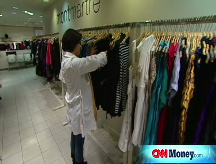Retail sales drop for 6th straight month
Slump in government reporter is the longest in at least four decades. Trade group says holiday sales down 2.8%, worse than forecast.
NEW YORK (CNNMoney.com) -- Retail sales fell for the sixth straight month in December, the longest consecutive stretch of monthly declines in the measure in at least four decades.
"Consumers aren't spending and that's not good for the economy," said Scott Hoyt, senior director of consumer economics with Moody's Economy.com.
In another sign of distress for the industry, the National Retail Federation reported Wednesday that 2008 holiday sales for the combined November-December months fell 2.8%.
This was the first-ever decline in the period since the trade group first started to track holiday sales in 1995.
Combined November-December sales can account for as much 50% of their annual merchants' profit and sales, making the months crucial.
The NRF had forecast a 2.2% sales gain for the year-end months, which would have been the weakest pace of increase in at least six years.
Retail sales reflect the state of consumer spending which in turn fuels two-thirds of the nation's economy.
To that end, the Commerce Department said Wednesday that retail sales tumbled 2.7% last month, compared with a revised 2.1% drop in November. November sales were originally reported to have fallen 1.8%.
Economists surveyed by Briefing.com on average had forecast a decrease of 1.2% for December.
Sales excluding autos and auto parts also fell a much worse-than-expected 3.1% in December, compared to a revised 2.5% decline in November. Sales minus auto purchases were originally reported to have declined 1.6% in November.
Economists had forecast a decrease of 1.3% in the measure, according to Briefing.com.
"We've never had this long stretch of declines," said Michael Niemira, chief economist with the International Council of Shopping Centers (ICSC), who has analyzed the government's monthly retail sales numbers going as far back as 1967.
"This current situation is a reflection of a tough, tough environment," he said. "Consumers are buying only essential items. Credit restraints have really impacted sales of big ticket purchases."
"Moving forward, the question is whether this is the low point and could we get some moderation in retail sales in 2009," Niemira said. "We haven't seen a lot of convincing data to that effect."
A steep 15.9% slump in gasoline station sales, which resulted from a plunge in prices at the pump, contributed to much of the weakness in core retail sales.
"The headlines are breathtaking, but they do overdo the gloom," Ian Shepherdson, chief U.S. economist with High Frequency Economics, said in a report Wednesday.
"Of the $9.4B drop in sales between November and December, just over half was due to the plunge in gas prices, which pushed gas sales down by $4.9B, or 15.9%, rather more than we expected," Shepherdson wrote. "Still, core sales were very weak."
Clothing purchases fell 2.5%, department store sales slumped 2.3%, sales in electronics stores fell 1%, general merchandise stores suffered a 1.3% sales decline, and sales of furniture and home furnishings fell 1.8% in the month.
Food and beverage sales dropped 1.4% while grocery stores logged a 1.3% sales drop in December.
"There's no a lot of impetus out there to turn this situation around," Hoyt said. "We're seeing huge job cuts, negative wealth effect, bonuses will be less than usual, credit has dried up and [consumer] confidence is exceptionally low."
"The key thing is correcting the jobs situation. As long as we're shedding jobs at a rapid rate, it doesn't matter what else you do," Hoyt added, referring to the NRF's push for states to offer periodic national sales tax holidays in 2009 as an incentive to get consumers to spend money in stores.
"These tax cuts have to be part of a broader solution to turn this downward cycle around," he said. ![]()


